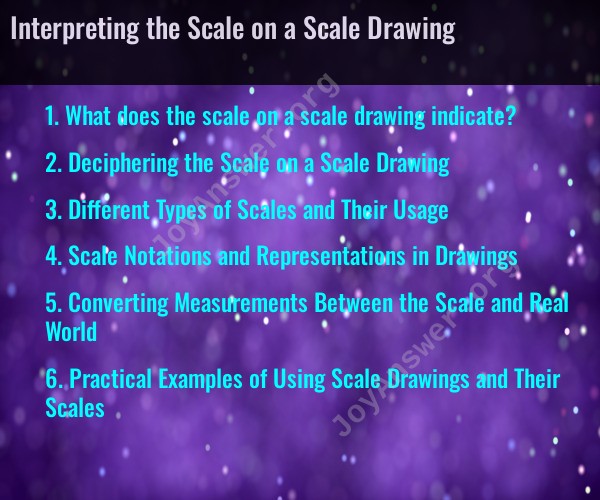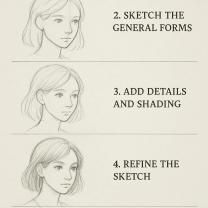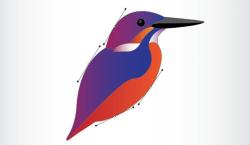What does the scale on a scale drawing indicate?
The scale on a scale drawing, often referred to as the "map scale" or "cartographic scale," indicates the relationship between the measurements on the drawing or map and the actual measurements in the real world. In other words, it tells you how much smaller the representation on the drawing is compared to the actual objects or terrain it represents.
A scale on a scale drawing is typically expressed in one of the following ways:
Representative Fraction (RF): This is a ratio that indicates how many units on the drawing correspond to how many units in the real world. For example, an RF of 1:10 means that 1 unit on the drawing represents 10 units in reality.
Verbal Scale: This is a description of the scale using words. For example, "1 inch on the map represents 1 mile in reality" is a verbal scale.
Graphic Scale: A graphic scale is a bar or line that is marked with distances. By comparing the length of the graphic scale to the lengths of features on the map, you can determine distances on the map.
The purpose of the scale on a scale drawing is to allow you to make accurate measurements and calculations when you need to determine distances, areas, or other dimensions in the real world based on the information provided on the drawing or map. It's an essential tool for map reading, navigation, and a variety of fields such as architecture, engineering, urban planning, and geography.
Deciphering the Scale on a Scale Drawing
The scale on a scale drawing is a ratio that represents the relationship between the size of the drawing and the size of the real object. The scale is usually written in the format of 1:n, where 1 represents the size of the drawing and n represents the size of the real object.
For example, a scale of 1:100 means that every 1 centimeter on the drawing represents 100 centimeters in the real world. A scale of 1:2 means that every 1 centimeter on the drawing represents 2 centimeters in the real world.
To decipher the scale on a scale drawing, simply look for the scale notation on the drawing. The scale notation is usually found in the lower right corner of the drawing.
Different Types of Scales and Their Usage
There are two main types of scales: representative and fractional.
- Representative scale: A representative scale is a scale that uses a symbol or abbreviation to represent the real-world size of the drawing. For example, a representative scale of 1/2" = 1' means that every 1/2 inch on the drawing represents 1 foot in the real world.
- Fractional scale: A fractional scale is a scale that is written in the format of 1:n, where 1 represents the size of the drawing and n represents the size of the real object. For example, a fractional scale of 1:100 means that every 1 centimeter on the drawing represents 100 centimeters in the real world.
Representative scales are often used in architectural drawings, engineering drawings, and other technical drawings. Fractional scales are often used in maps and other drawings that represent large areas.
Scale Notations and Representations in Drawings
Scale notations and representations in drawings can vary depending on the type of drawing and the intended audience.
For example, architectural drawings and engineering drawings typically use a representative scale. The scale notation for a representative scale is usually written in the format of 1/2" = 1' or 1:100.
Maps typically use a fractional scale. The fractional scale for a map is usually written in the format of 1:24,000 or 1:100,000.
Converting Measurements Between the Scale and Real World
To convert a measurement from the scale to the real world, simply multiply the measurement on the drawing by the scale. For example, if a scale drawing of a house has a scale of 1/4" = 1', then a measurement of 2" on the drawing would represent a measurement of 8' in the real world.
To convert a measurement from the real world to the scale, simply divide the measurement in the real world by the scale. For example, if a house is 32' long in the real world and the scale drawing of the house has a scale of 1/4" = 1', then the measurement of the house on the drawing would be 8".
Practical Examples of Using Scale Drawings and Their Scales
Scale drawings are used in a variety of industries and applications, including:
- Architecture: Scale drawings are used to create blueprints and other construction drawings.
- Engineering: Scale drawings are used to create engineering drawings for machines, structures, and other systems.
- Manufacturing: Scale drawings are used to create manufacturing drawings for products.
- Cartography: Scale drawings are used to create maps and other cartographic products.
Scale drawings can also be used for personal projects, such as home improvement projects and woodworking projects.
Here are some practical examples of using scale drawings and their scales:
- A contractor might use a scale drawing of a house to plan a home renovation project.
- An engineer might use a scale drawing of a machine to troubleshoot a problem.
- A manufacturer might use a scale drawing of a product to create a prototype.
- A cartographer might use a scale drawing to create a map of a new neighborhood.
- A homeowner might use a scale drawing of a kitchen to plan a kitchen remodel.
- A woodworker might use a scale drawing of a piece of furniture to build it.
Scale drawings are a valuable tool that can be used to accurately represent objects and systems of all sizes.












